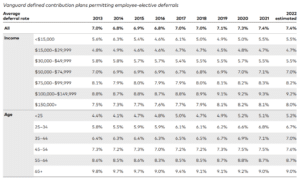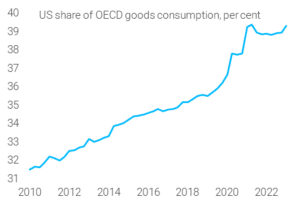Every year Vanguard releases its How America Saves report which details what percentage of income people are saving into their retirement accounts.

The average savings rate among Vanguard accounts in 2022 was 7.4%.
Here’s a breakdown of the average savings rates across different income levels and age groups:

The overall average has remained pretty consistent at around 7% over the past 10 years. That number is higher than I was expecting. I assume this has something to do with the people who have opened Vanguard investment accounts being more inclined to save than the average person.
According to Statista and a few other sources, the national average savings rate is around 3% to 4% currently.
The average savings rate across the country spiked in April of 2020 to a whopping 33% at the onset of the pandemic but has been on a steady decline ever since.
This is stating the obvious, but in order to have money to save and invest you first need to keep your spending in check. In the early days of the pandemic, there were very few opportunities to spend money so people ended up saving a lot of their income.
As the economy has opened back up, extra savings combined with pent-up demand for buying stuff has led to a spending boom over the past couple of years:

This trend was already in motion but you can see how it’s gone to another level since 2020.

This increase in spending is a big reason why the U.S. economy has stayed strong despite many calling for a recession. One person’s spending is another person’s income. Consumer spending makes up around 70% of the economy and people are still spending liberally.
But while spending is beneficial to the economy as a whole, thoughtless spending can have a negative impact on individuals’ finances. Hence the severe drop in personal savings rates.
There’s a limit to how far you can let your spending increase before it starts affecting your financial future. The reason it can be so damaging is that every increase in spending negatively affects your finances twofold:
• it decreases the amount of money you have left over to save each month
• it increases the amount of money you’ll need to replace when you slow down or stop working
This concept also works in reverse. The more you save the less you’ll spend, and the less you spend the smaller nest egg you’ll need to live off of in retirement.

What is an ideal savings rate?
Vanguard suggests a 12% to 15% savings rate to be able to reach retirement goals.
How much you should be savings depends heavily on how much you spend and your own personal situation, but as a general rule, I would recommend saving anywhere from 15% to 20% of your total gross income.
A recent survey by Schroders revealed the percentage of Americans nearing retirement age (60-67) who said they have enough money saved was just 24%.
However, the stock market has produced awesome returns over the past few decades. Since 1983, the U.S. stock market is up 7,396% or 11% per year. In other words, $10,000 invested in 1983 would be worth $749,624 today.
So for those who don’t feel like they have enough money to retire, it likely isn’t because of an investment problem, but a savings problem.
If you asked someone who’s about to retire what they wish they would’ve done when they were younger to put them in a better position today, I’m confident most would say they wish they would’ve started saving earlier.
Thanks for reading!

